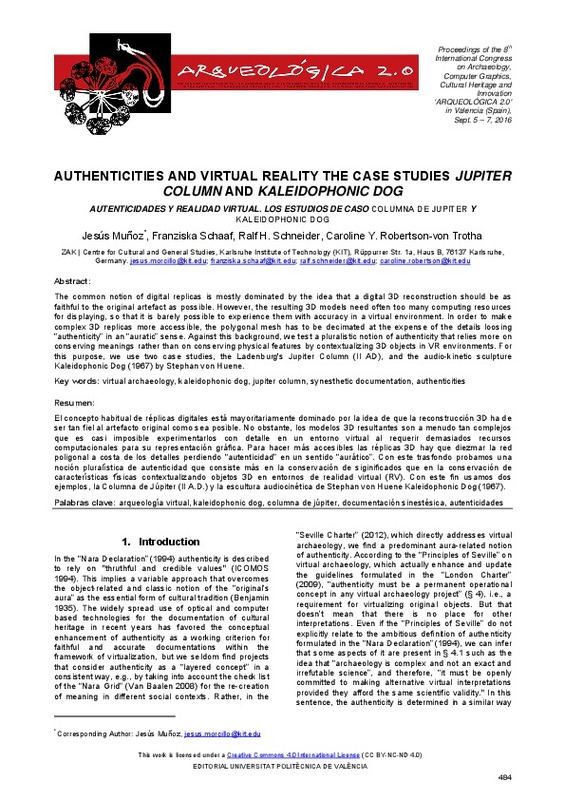JavaScript is disabled for your browser. Some features of this site may not work without it.
Buscar en RiuNet
Listar
Mi cuenta
Estadísticas
Ayuda RiuNet
Admin. UPV
AUTHENTICITIES AND VIRTUAL REALITY THE CASE STUDIES JUPITER COLUMN AND KALEIDOPHONIC DOG
Mostrar el registro sencillo del ítem
Ficheros en el ítem
| dc.contributor.author | Muñoz Morcillo, Jesús
|
es_ES |
| dc.contributor.author | Schaaf, Franziska
|
es_ES |
| dc.contributor.author | Schneider, Ralf
|
es_ES |
| dc.contributor.author | Robertson-von Trotha, Caroline Y.
|
es_ES |
| dc.date.accessioned | 2017-07-24T07:07:01Z | |
| dc.date.available | 2017-07-24T07:07:01Z | |
| dc.date.issued | 2016-10-27 | |
| dc.identifier.isbn | 9788490484555 | |
| dc.identifier.uri | http://hdl.handle.net/10251/85629 | |
| dc.description.abstract | [EN] The common notion of digital replicas is mostly dominated by the idea that a digital 3D reconstruction should be as faithful to the original artefact as possible. However, the resulting 3D models need often too many computing resources for displaying, so that it is barely possible to experience them with accuracy in a virtual environment. In order to make complex 3D replicas more accessible, the polygonal mesh has to be decimated at the expense of the details loosing “authenticity” in an “auratic” sense. Against this background, we test a pluralistic notion of authenticity that relies more on conserving meanings rather than on conserving physical features by contextualizing 3D objects in VR environments. For this purpose, we use two case studies, the Ladenburg's Jupiter Column (II AD), and the audio-kinetic sculpture Kaleidophonic Dog (1967) by Stephan von Huene. | es_ES |
| dc.description.abstract | [ES] El concepto habitual de réplicas digitales está mayoritariamente dominado por la idea de que la reconstrucción 3D ha de ser tan fiel al artefacto original como sea posible. No obstante, los modelos 3D resultantes son a menudo tan complejos que es casi imposible experimentarlos con detalle en un entorno virtual al requerir demasiados recursos computacionales para su representación gráfica. Para hacer más accesibles las réplicas 3D hay que diezmar la red poligonal a costa de los detalles perdiendo “autenticidad” en un sentido “aurático”. Con este trasfondo probamos una noción pluralística de autenticidad que consiste más en la conservación de siginificados que en la conservación de características físicas contextualizando objetos 3D en entornos de realidad virtual (RV). Con este fin usamos dos ejemplos, la Columna de Júpiter (II A.D.) y la escultura audiocinética de Stephan von Huene Kaleidophonic Dog (1967). | es_ES |
| dc.format.extent | 4 | es_ES |
| dc.language | Inglés | es_ES |
| dc.publisher | Editorial Universitat Politècnica de València | es_ES |
| dc.relation.ispartof | 8th International congress on archaeology, computer graphics, cultural heritage and innovation | es_ES |
| dc.rights | Reconocimiento - No comercial - Sin obra derivada (by-nc-nd) | es_ES |
| dc.subject | Data acquisition | es_ES |
| dc.subject | Photogrammetry | es_ES |
| dc.subject | Remote sensing | es_ES |
| dc.subject | Documentation | es_ES |
| dc.subject | Cultural heritage | es_ES |
| dc.subject | Digitisation | es_ES |
| dc.subject | 3D modelling | es_ES |
| dc.subject | Virtual archaeology | es_ES |
| dc.subject | Virtual museums | es_ES |
| dc.subject | Virtual exhibitions | es_ES |
| dc.subject | Gaming | es_ES |
| dc.subject | Collaborative environments | es_ES |
| dc.subject | Internet technology | es_ES |
| dc.subject | Social media | es_ES |
| dc.subject | Architecture | es_ES |
| dc.title | AUTHENTICITIES AND VIRTUAL REALITY THE CASE STUDIES JUPITER COLUMN AND KALEIDOPHONIC DOG | es_ES |
| dc.title.alternative | AUTENTICIDADES Y REALIDAD VIRTUAL. LOS ESTUDIOS DE CASO COLUMNA DE JUPITER Y KALEIDOPHONIC DOG | es_ES |
| dc.type | Capítulo de libro | es_ES |
| dc.type | Comunicación en congreso | es_ES |
| dc.identifier.doi | 10.4995/arqueologica8.2015.4176 | |
| dc.rights.accessRights | Abierto | es_ES |
| dc.description.bibliographicCitation | Muñoz Morcillo, J.; Schaaf, F.; Schneider, R.; Robertson-Von Trotha, CY. (2016). AUTHENTICITIES AND VIRTUAL REALITY THE CASE STUDIES JUPITER COLUMN AND KALEIDOPHONIC DOG. En 8th International congress on archaeology, computer graphics, cultural heritage and innovation. Editorial Universitat Politècnica de València. 484-487. https://doi.org/10.4995/arqueologica8.2015.4176 | es_ES |
| dc.description.accrualMethod | OCS | es_ES |
| dc.relation.conferencename | ARQUEOLÓGICA 2.0 - 8th International Congress on Archaeology, Computer Graphics, Cultural Heritage and Innovation | es_ES |
| dc.relation.conferencedate | September 05-07,2016 | es_ES |
| dc.relation.conferenceplace | Valencia, Spain | es_ES |
| dc.relation.publisherversion | http://ocs.editorial.upv.es/index.php/arqueologica20/arqueologica8/paper/view/4176 | es_ES |
| dc.description.upvformatpinicio | 484 | es_ES |
| dc.description.upvformatpfin | 487 | es_ES |
| dc.type.version | info:eu-repo/semantics/publishedVersion | es_ES |
| dc.relation.pasarela | OCS\4176 | es_ES |








